Are you struggling to prepare your project for printing or exporting to a PDF file? In today’s world, it might seem surprising that many project managers still need to perform these tasks. However, fear not! I’m here to guide you through the process of how to print a project schedule, step by step, ensuring that you achieve consistent and impressive results every time. Stick with me until the end, and I’ll even show you how to insert a manual page break, similar to what you might do in Microsoft Word. So let’s dive in! And if you would prefer to watch the YouTube video on this subject, click here or click the thumbnail below.
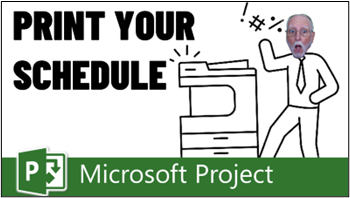
How to Print a Project Schedule: Getting Started
Before we jump into the details for how to print a project schedule, make sure you’re in the Gantt Chart view. Now, let’s break down the process into easy-to-follow steps.
Step 1: Apply the Gantt Chart View
First things first, apply the Gantt Chart view to your project. This will serve as the foundation for your printing or PDF export.
- Click on the “View” tab at the top
- Click the “Gantt Chart” Icon at the left
- Click the “Gantt Chart” built-in view
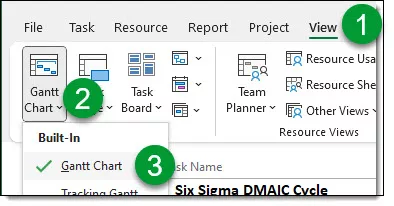
Step 2: Hide Columns
To make sure we have a clean print out, let’s remove any unnecessary columns that you don’t want to include in your printout. Right-click on the column headers you want to hide and select “Hide Column.” Adjust column widths to ensure everything fits neatly.
- Right click on the column you want to hide
- Then click the “Hide Colum”
- Repeat as necessary
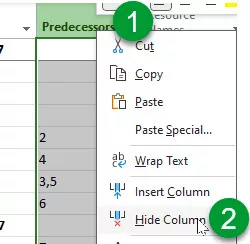
Step 3: Position the Split Bar
Position the split bar exactly where you want it to appear in the printout. A useful trick: double-click the split bar after placing it near the desired column edge to dock it accurately.
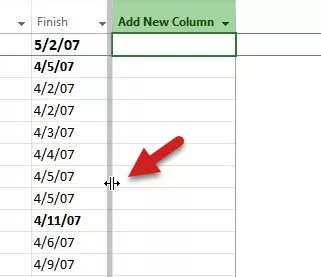
Step 4: Count the Columns
Determine the number of columns you want to print on each page. But don’t forget to count all the columns, including any hidden ones! This is important for the next step.
Step 5: Optimize Zoom Level
Set the zoom level for the Gantt Chart screen to “Entire Project.” This helps reduce the number of pages printed. Don’t forget to examine the print preview to ensure it meets your expectations.
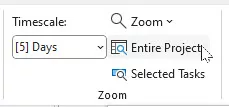
Step 6: Set Up: Print Page Setup
Navigate to the Print Page Setup dialog. You can access this by
- Click the “File” tab then “Print”
- Then click the “Page Setup” link at the lower right
- Then click the “View” tab in the dialogue box
- Last step that usually no one know about is check the box for the “Print first” then enter the number of columns you want to show.
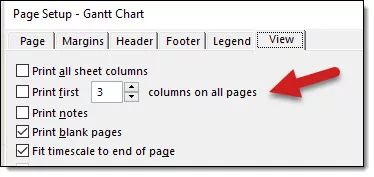
Fine-Tuning the Printing Options
Now that your initial setup is complete, let’s fine-tune the printing options for perfection.
Step 7: Adjust Scaling
In the Page Setup dialog, find the “Scaling” section. Experiment with scaling options until you achieve the desired print size. This ensures legibility in your printout or PDF.
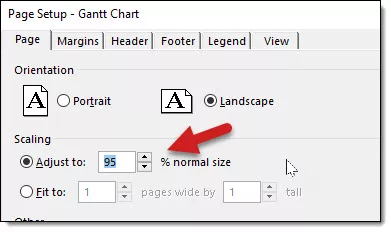
Step 8: Custom Headers and Footers
If you want to include a custom header or footer, access the header and footer settings in the Page Setup dialog. You can add text, fields, or other details to personalize your printout.
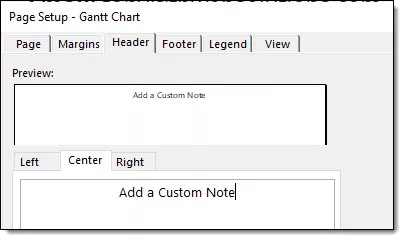
Step 9: Test Print or Save to PDF
Perform a test print or save your project as a PDF file to see how it looks. Ensure that everything aligns, columns are readable, and the overall layout meets your expectations. Adjust settings if necessary.
Saving Your Custom View
Now that your settings are perfect, it’s time to save your custom view for future use.
Step 10: Save the Custom View
Click the “Task” ribbon tab, click the “Gantt Chart” pick list button, and select the “Save View” option. Name your view something distinctive, like “Print View.” This custom view will save all the settings you’ve configured.
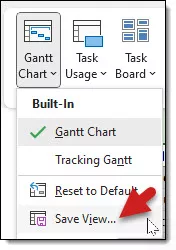
Restoring Default Settings
Lastly, after all your printing is done, you’ll want to restore the Gantt Chart view to its default settings.
Step 11: Reset to Default
Click the “Gantt Chart” pick list button again and choose “Reset to Default.” This will revert your Gantt Chart view back to its original settings, ready for your next project.
Bonus: Inserting Manual Page Breaks
Sometimes, you may want to insert a manual page break in your printout. Here’s how:
Step 12: Insert a Manual Page Break
Access the “File” tab, then go to “Options.” In the “Quick Access Toolbar” section, choose “All Commands” and find “Insert Page Break.” Add this command to your Quick Access Toolbar. Now, you can click this button to insert page breaks where needed.
**If you haven’t installed my custom Quick Access Toolbar, check out this article and there’s a video to show you the steps also.
Congratulations! You’ve successfully set up your project for printing or exporting to a PDF file. With your customized view and newfound knowledge of manual page breaks, you’re ready to impress with polished and professional project documentation. Remember, experimentation is key to finding the perfect settings that suit your project’s needs. Enjoy your newfound printing prowess!
If you have questions, please add them in the Comments section below. Or if you watch the video, add your questions or comments there. Please subscribe to my YouTube channel and leave “Likes” if you like the videos.
If you would like to have a formal class on using Microsoft Project, here is a link for my classes.

Dale Howard
Microsoft Project MVP “20 Years”
About Me
Hello there Microsoft Project lovers! I’m Dale Howard and I’ve been a Microsoft Project MVP (Most Valuable Professional) for 20 years in a row and I’m currently one of only 26 Project MVPs in the entire world. Pretty exciting, right!?
If you post a question about any of Microsoft’s PPM tools on the public message boards, look to see who the moderator or person that has answered the questions and you see, it’s frequently me answering your questions. Some people like to golf, I love Microsoft Project helping the community get to understand Microsoft Project much better.
I’ve been teaching students at all levels for over 20 years and have taught thousands of users around the world. I’ve written and co-authored 23 books on Microsoft Project, Project Online, and Project Server so if you’re like me and like to read over watching a video, you can Check Out My Books on Amazon.
For the people that like to watch videos, check out my YouTube channel. If you post a question in the comments, I’ll be happy to answer questions or create a new video to answer your question.
If you’ve got a question about Microsoft Project, Project Online or Project Server, check out some of these community post areas below where I am the moderator and have been answering questions on these message boards for over 20 years.
Microsoft Tech Community
Reddit Project Online Community
LinkedIn Project and Planner Group
My Students Include:
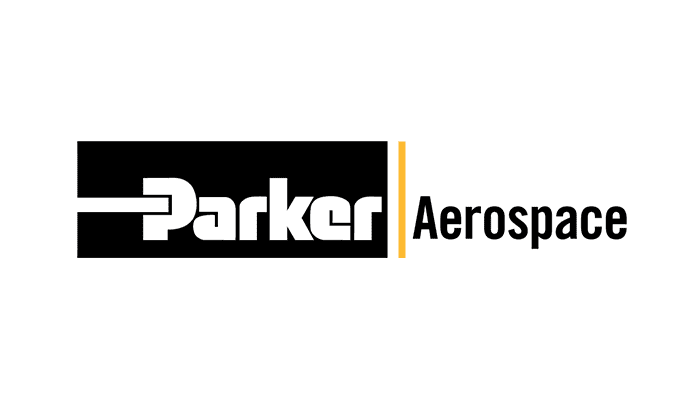
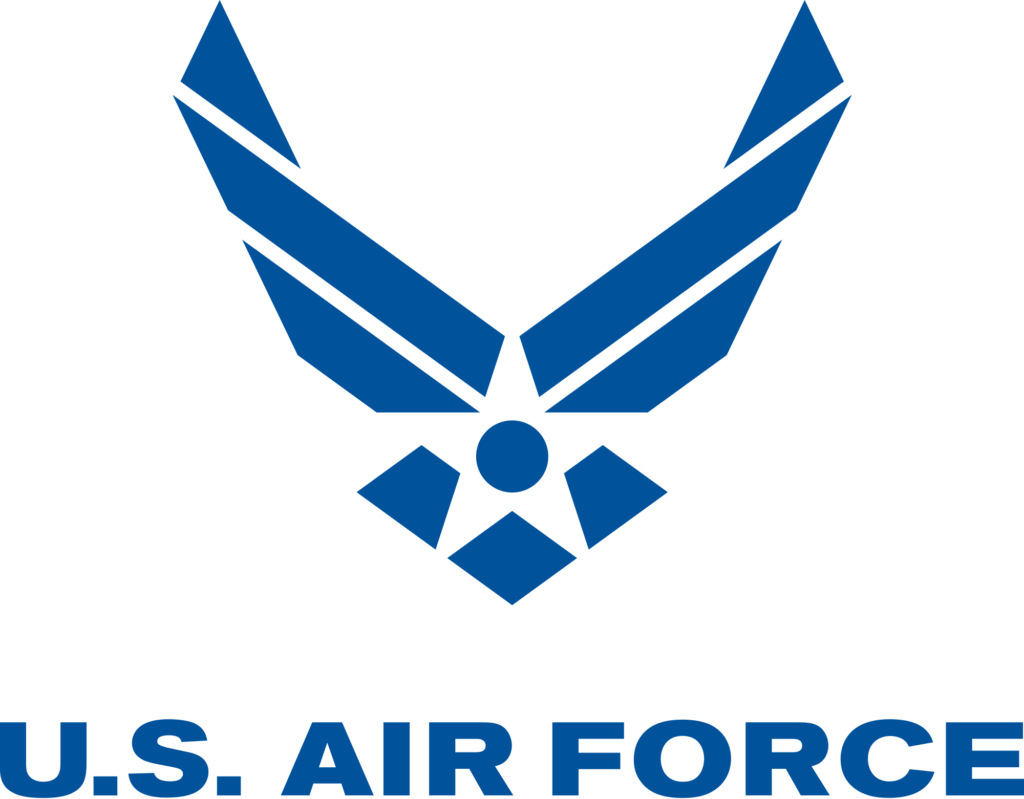


What Type of Microsoft Project Training Do You Need?
Individual and Small Group Training
OnDemand Training at your own pace
Starting at $399

OnDemand Training

Microsoft Project Standard Desktop Training

Microsoft Project Professional Desktop for Project Online Training

Microsoft Project Professional Desktop for Project Server Training

Templates, Student Hand Outs, Tips and Tricks

Certificate of Completion
Medium & Large Group Training
Onsite, Virtual or OnDemand Training
Contact Me for Discounts

Microsoft Project Standard Desktop Training

Microsoft Project Professional Desktop for Project Online Training

Microsoft Project Professional Desktop for Project Server Training

Templates, Student Hand Outs, Tips and Tricks

Certificate of Completion

Automated Training Progress Report
FAQ
What is Microsoft Project Dynamic Scheduling?
Microsoft Project Dynamic Scheduling is a feature within Microsoft Project that allows you to create flexible project plans, update schedules based on changing circumstances, and optimize resource allocation.
How can Microsoft Project Dynamic Scheduling benefit my project management?
Microsoft Project Dynamic Scheduling can benefit your project management by enabling efficient planning, increased productivity, and the ability to adapt to changes, allowing your projects to thrive.
What role does dynamic scheduling play in effective project management?
Dynamic scheduling plays a crucial role in effective project management by helping you stay on track, manage resources efficiently, and meet project goals.
What features does Microsoft Project offer for dynamic scheduling?
Microsoft Project offers various features and functions for dynamic scheduling, allowing you to create flexible project plans, update schedules in real-time, and optimize resource allocation.
How does dynamic scheduling optimize resource allocation?
Dynamic scheduling in Microsoft Project optimizes resource allocation by providing a flexible project schedule that can adapt to changes in resource availability, ensuring efficient utilization and maximizing productivity.
How does dynamic scheduling streamline project execution?
Dynamic scheduling streamlines project execution by providing a real-time, updated project schedule that enables effective communication, task prioritization, and timely decision-making throughout the project lifecycle.
How does dynamic scheduling enhance collaboration within Microsoft Project?
Dynamic scheduling enhances collaboration in Microsoft Project by offering collaborative features that promote effective communication, facilitate teamwork, and foster a shared understanding of project goals and progress among team members.
How does dynamic scheduling help track progress and manage risks?
Dynamic scheduling in Microsoft Project helps track progress and manage project risks by providing real-time updates and customizable reports that allow you to identify potential bottlenecks, mitigate risks, and take proactive actions to keep your project on track.
How can dynamic scheduling in Microsoft Project leverage data and insights for continuous improvement?
Dynamic scheduling in Microsoft Project provides valuable data and insights for continuous improvement by analyzing project performance metrics, identifying trends, and making data-driven decisions to enhance project outcomes and increase overall efficiency.
Leave a Reply